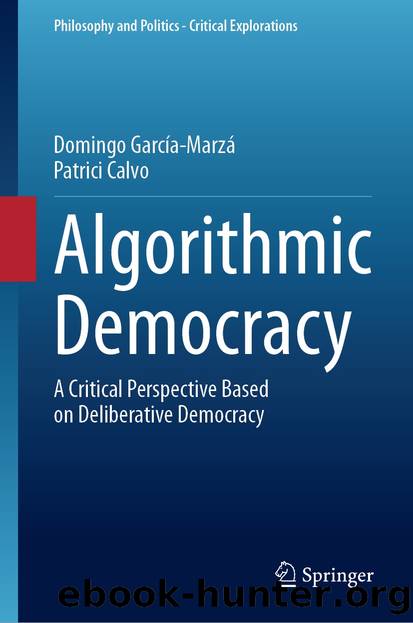Algorithmic Democracy by Domingo García-Marzá & Patrici Calvo

Author:Domingo García-Marzá & Patrici Calvo
Language: eng
Format: epub
ISBN: 9783031530159
Publisher: Springer International Publishing
7.2 Cryptoeconomics: Ethical Aspects of the NFT Revolution
The irruption of blockchain technology has led to a revolution for the art world, the consequences of its unprecedented disruptive process are being strongly felt across all its areas and dimensions: economic, artistic, theoretical, aesthetic, reflective, sustainable, moral, etc. The emergence of so-called crypto-art or cryptographic digital art is of particular relevance. It is based on NFTs, smart contracts and cryptocurrencies which, according to their advocates, guarantees the ownership, authenticity, scarcity, exclusivity, immutability, verifiability and traceability of digital works.
Although there are precedents for this development, crypto-art was consolidated in 2017 through the trade in digital artworks. Until then, the problem with digital artworks was their high and rapid rate of replication across the network, which hindered the possibility of giving them a market value. Scarcity as a dominant value of economics was extensively discussed by Carl Mengerâfounder of the Austrian School and one of the fathers of the marginalist revolution along with William Stanley Jevons and Leon Walrasâin his seminal book Principles of Economics (1871). For Menger, economic goods are the source of individualsâ personal progress in a society, as their consumption allows for optimal states of individual well-being. However, unlike non-economic goods, they are scarce and their appropriation is limited. Therefore, as they can never meet the existing demandâif they did, they would not be economicâagents must compete with each other to appropriate these goods and thereby satisfy their needs and desires, which is what underpins the development of these commodities. By focusing his study on the analysis of the scarcity of consumer goods, the appropriation of the best mechanisms to satisfy them, and the underlying competitiveness, Menger laid the foundations of the modern concept of economics, as â(â¦) the science which studies human behaviour as a relationship between given ends and scarce means which have alternative usesâ (Robbins 1932, 15).
Using the blockchain technology that supports the Ethereum cryptocurrencyâfungible, exchangeable tokensâdigital artists were able to endow their works with an aura of scarcity, authenticity and proprietary control through tokenization; that is, by converting them into NFTs, which are non-exchangeable resources recognized, encrypted and protected by this cryptographic platform.
Tokenization is the process of turning anything into a scarce digital asset through the â(â¦) encapsulation of value in tradeable units of account, called tokensâ (Freni et al. 2020). Thus, through the â(â¦) creation of a self-governed (tok)economic system, whose rules are programmed by the token designerâ (Freni et al. 2020), tokenization offers the possibility of creating digital scarcity and, at the same time, eliminating the commercial intermediation that makes works of art more expensive, saving time and money in transactions and, therefore, lowering costs and improving profits.
From then on, the market value of digital works began to be established, and rose exponentially; on 11 March 2021 Mike Winkelmann, aka Beeple, sold his digital work Everydays: The First 5000 Days for 57 million euros (Fairfield and Trautman 2021; Joselit 2021; Dean 2021).
With the sale of Beepleâs work, the trade in crypto-art or cryptographic digital art
Download
This site does not store any files on its server. We only index and link to content provided by other sites. Please contact the content providers to delete copyright contents if any and email us, we'll remove relevant links or contents immediately.
In-Memory Analytics with Apache Arrow by Matthew Topol(2726)
PostgreSQL 14 Administration Cookbook by Simon Riggs(2258)
Cloud Auditing Best Practices: Perform Security and IT Audits across AWS, Azure, and GCP by building effective cloud auditing plans by Shinesa Cambric Michael Ratemo(2122)
Architects of Intelligence_The Truth About AI From the People Building It by Martin Ford(1270)
In-Memory Analytics with Apache Arrow: Perform fast and efficient data analytics on both flat and hierarchical structured data by Matthew Topol(1080)
Mastering Azure Virtual Desktop: The Ultimate Guide to the Implementation and Management of Azure Virtual Desktop by Ryan Mangan(1054)
Automated Machine Learning in Action by Qingquan Song Haifeng Jin Xia Hu(941)
Python GUI Programming with Tkinter, 2nd edition by Alan D. Moore(915)
Learn Wireshark - A definitive guide to expertly analyzing protocols and troubleshooting networks using Wireshark - 2nd Edition (2022) by Packt(792)
Ansible for Real-Life Automation - A complete Ansible handbook filled with practical IT automation use cases (2022) by Packt(784)
Data Engineering with Scala and Spark by Eric Tome Rupam Bhattacharjee David Radford(465)
Introduction to Algorithms, Fourth Edition by unknow(437)
ABAP Development for SAP HANA by Unknown(391)
Automated Machine Learning in Action by Qingquan Song & Haifeng Jin & Xia Hu(338)
Kubernetes Secrets Handbook by Emmanouil Gkatziouras | Rom Adams | Chen Xi(317)
The AWK Programming Language by Aho Alfred V. Kernighan Brian W. Weinberger Peter J. & Brian W. Kernighan & Peter J. Weinberger(315)
Asynchronous Programming in Rust by Carl Fredrik Samson;(290)
Learn Enough Developer Tools to Be Dangerous: Git Version Control, Command Line, and Text Editors Essentials by Michael Hartl(287)
Machine Learning for Imbalanced Data by Kumar Abhishek Dr. Mounir Abdelaziz(287)
